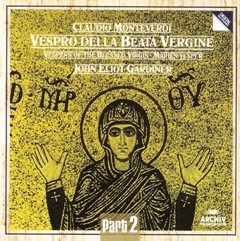111 Years of Deutsche Grammophon - CD 19
111 Years of Deutsche Grammophon - CD 19
Monteverdi: Vespro della Beata Vergine (1610)

1 Sonata sopra Sancta Maria a 1 [6:54] 2 Ave maris stella a 8 [8:55] 3 Magnificat I a 7 [17:38] 4 Magnificat II a 6 [18:28] Mark Tucker, Nigel Robson, Ann Monoyios, Marinella Pennicchi, Sandro Naglia, Bryn Terfel, Alastair Miles, Michael Chance, Marinella Pennicchi, English Baroque Soloists, Ian Watson, The Monteverdi Choir, The London Oratory Junior Choir, Patrick Russill John Eliot Gardiner – conductor
The historical interest of this work is almost as great as its inherent qualities. Vespers are part of the daily Offices, or Canonical Hours, of the church, music for the Offices including psalms (with antiphons), hymns, and canticles, as well as chanted lessons (with responsories). Although inspired by the Church Office, Monteverdi's Vespers in many ways transcends the original concept, perfectly exemplifying the transition between austere Renaissance polyphony and sheer Baroque splendor. Monteverdi makes his characteristic contribution to sacred music in a bold, almost operatic, style, complete with daring stereophonic and echo effects, and includes a suite of instrumental dances, concerti sections for both voices and orchestra, and a love song. To what extent this is liturgical music is debatable in view of the choice of texts, which some in Monteverdi's time considered blasphemous. Completed in 1610, the Vespers was written for the court of the Gonzaga family in Mantua, where Monteverdi was employed from 1590 to 1612, and dedicated to Pope Paul V. But the composition's true home is undoubtedly the cathedral of St. Mark in Venice, where Monteverdi was appointed maestro di cappella in 1613. Indeed, the Vespers could well have been conceived with its echoing spaces, galleries, balconies, organ, and choir lofts in mind.
The sections contain striking contrasts, but the unity and continuity of Monteverdi's grand design is maintained theatrically as well as musically. The overture, for choir and orchestra, is manifestly operatic, and close to that of Monteverdi's first opera, Orfeo -- an upsurge of joyous energy, interposed by an orchestral toccata and ending with a jubilant Alleluia. The instrumentation (cornets, sackbuts, a variety of single and double reeds, recorders, strings, organ, and harpsichord) is, with the exception of the instrumental ritornelli, mainly intended to contribute to the formal structure of the choral sections, coloring the choir in the manner of organ stops, as in the "Dixit Dominus," "Laetatus sum," "Audi, coelum," and the beginning and end of the closing Magnificat, the climax of the whole work. The ways in which Monteverdi treats the cantus firmus by incorporating it into the counterpoint of the choral writing, as in "Dixit Dominus" (Psalm 109), is not found in earlier choral literature, nor is the flowing, unfettered parlando (recitation) style used in "Nigra sum," a metrically free poem with allusions to the biblical Song of Solomon. The concerto "Due Seraphim" is probably the most interesting section in the Vespers. It is set for two "answering" voices -- a sort of singing competition for angels -- and almost exceeds the limits of human vocal technique. The choral writing is also demanding in its splendor and complexity, much of it in six, seven, and, as in the psalm "Laudate pueri," eight parts; yet the simplicity of the two-part hymn Ave Maris stella is also among the many treasures of this magnificent work.
It has not been easy to arrive at satisfactory modern performing editions of the Vespers, and interpretations differ in important details. The title page of the first edition is inscribed "ad Sacella sive Principum Cubicula accomodata Opera" (for use in princely rooms and chapels)," but unfortunately several modern editors have attempted to regard it as a vast choral work, ignoring the comparatively small forces needed to realize its grandeur. This work was little known and not recorded until the 1930s, when musicologists and scholars, such as Nadia Boulanger, researched the puzzles and complexities of authentic Baroque performance. --- Roy Brewer, Rovi








